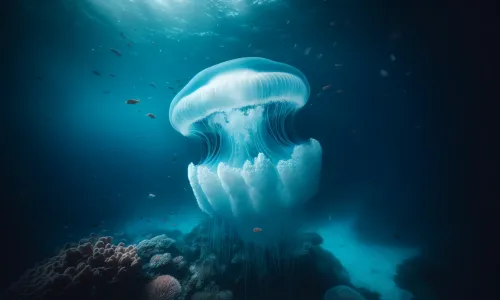
When viewed in the wild, jellyfish are perhaps the most graceful and vividly coloured of all sea creatures. But few people have seen a jellyfish living in its natural habitat. Instead, they might see a dead and shapeless specimen lying on the beach, or perhaps receive a painful sting while swimming, so it is inevitable that jellyfish are often considered ugly and possibly dangerous. This misunderstanding can be partly traced back to the 20th century, when the use of massive nets and mechanical winches often damaged the delicate jellyfish that scientists managed to recover. As a result, disappointingly little research was carried out into jellyfish, as marine biologists took the easy option and focused on physically stronger species such as fish, crabs and shrimp. Fortunately, however, new techniques are now being developed. For example, scientists have discovered that sound bounces harmlessly off jellyfish, so in the Arctic and Norway researchers are using sonar to monitor jellyfish beneath the ocean’s surface. This, together with aeroplane surveys, satellite imagery and underwater cameras, has provided a wealth of new information in recent years.
Scientists now believe that in shallow water alone there are at least 38 million tonnes of jellyfish and these creatures inhabit every type of marine habitat, including deep water. Furthermore, jellyfish were once regarded as relatively solitary, but this is another area where science has evolved. Dr Karen Hansen was the first to suggest that jellyfish are in fact the centre of entire ecosystems, as shrimp, lobster, and fish shelter and feed among their tentacles. This proposition has subsequently been conclusively proven by independent studies. DNA sequencing and isotope analysis have provided further insights, including the identification of numerous additional species of jellyfish unknown to science only a few years ago.
This brings us to the issue of climate change. Research studies around the world have recorded a massive growth in jellyfish populations in recent years and some scientists have linked this to climate change. However, while this may be credible, it cannot be established with certainty as other factors might be involved. Related to this was the longstanding academic belief that jellyfish had no predators and therefore there was no natural process to limit their numbers. However, observations made by Paul Dewar and his team showed that this was incorrect. As a result, the scientific community now recognises that species including sharks, tuna, swordfish and some salmon all prey on jellyfish.
It is still widely assumed that jellyfish are among the simplest lifeforms, as they no brain or central nervous system. While this is true, we now know they possess senses that allow them to see, feel and interact with their environment in subtle ways. What is more, analysis of so-called ‘upside-down jellyfish’ shows that they shut down their bodies and rest in much the same way that humans do at night, something once widely believed to be impossible for jellyfish. Furthermore, far from ‘floating’ in the water as they are still sometimes thought to do, analysis has shown jellyfish to be the most economical swimmers in the animal kingdom. In short, scientific progress in recent years has shown that many of our established beliefs about jellyfish were inaccurate.
Jellyfish, though, are not harmless. Their sting can cause a serious allergic reaction in some people and large outbreaks of them – known as ‘blooms’ – can damage tourist businesses, break fishing nets, overwhelm fish farms and block industrial cooling pipes. On the other hand, jellyfish are a source of medical collagen used in surgery and wound dressings. In addition, a particular protein taken from jellyfish has been used in over 30,000 scientific studies of serious diseases such as Alzheimer’s. Thus, our relationship with jellyfish is complex as there are a range of conflicting factors to consider.
Jellyfish have existed more or less unchanged for at least 500 million years. Scientists recognise that over the planet’s history there have been three major extinction events connected with changing environmental conditions. Together, these destroyed 99% of all life, but jellyfish lived through all three. Research in the Mediterranean Sea has now shown, remarkably, that in old age and on the point of death, certain jellyfish are able to revert to an earlier physical state, leading to the assertion that they are immortal. While this may not technically be true, it is certainly an extraordinary discovery. What is more, the oceans today contain 30% more poisonous acid than they did 100 years ago, causing problems for numerous species, but not jellyfish, which may even thrive in more acidic waters. Jellyfish throughout their long history have shown themselves to be remarkably resilient.
Studies of jellyfish in class known as scyphozoa have shown a life cycle of three distinct phases. First, thousands of babies known as planulae are released. Then, after a few days the planulae develop into polyps – stationary lifeforms that feed off floating particles. Finally, these are transformed into something that looks like a stack of pancakes, each of which is a tiny jellyfish. It is now understood that all species of jellyfish go through similarly distinct stages of life. This is further evidence of just how sophisticated and unusual these lifeforms are.